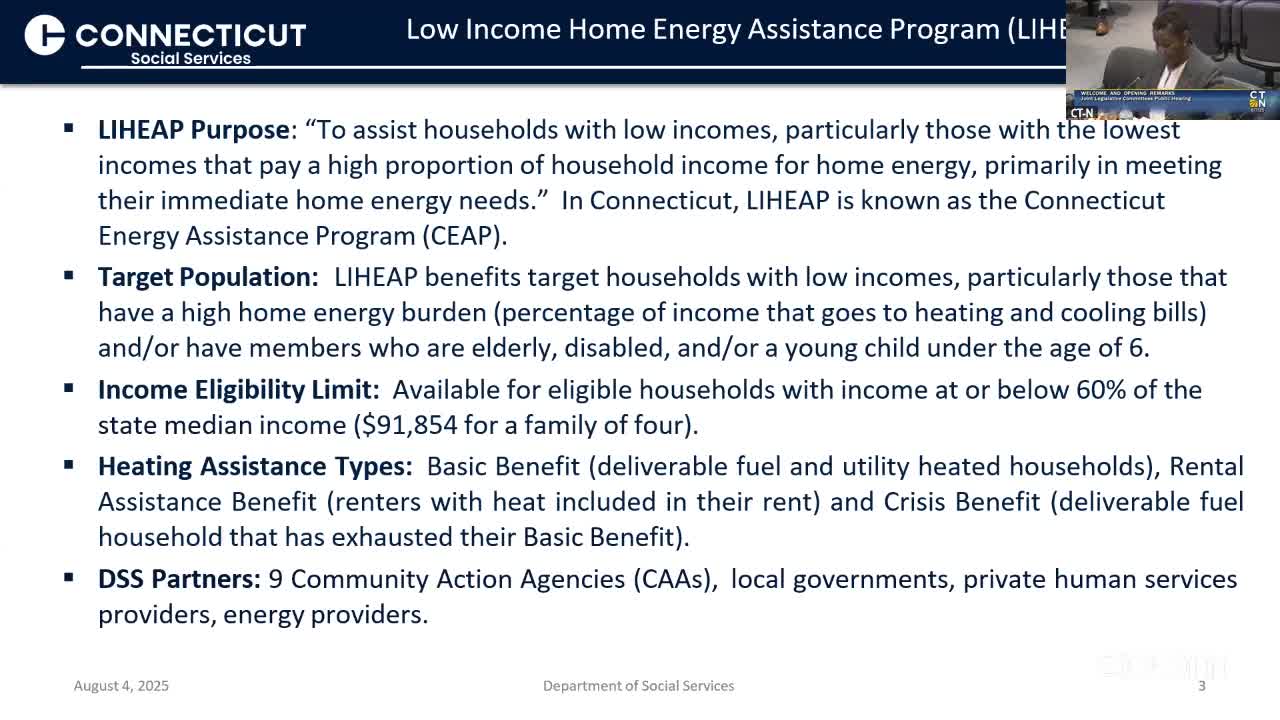Connecticut's LIHEAP Program Supports Low-Income Families With Heating Assistance
August 07, 2025 | Appropriations, House of Representatives, Committees, Legislative, Connecticut
This article was created by AI summarizing key points discussed. AI makes mistakes, so for full details and context, please refer to the video of the full meeting. Please report any errors so we can fix them. Report an error »

The Connecticut State Legislature held a public hearing on August 7, 2025, to discuss the Federal Fiscal Year 2026 Low-Income Home Energy Assistance Program (LIHEAP) Plan. The primary focus of the meeting was to outline the purpose and benefits of LIHEAP, which aims to assist low-income families with heating and cooling costs.
LIHEAP is part of the Connecticut Emergency Assistance Program and is federally funded and administered. The program targets households with low incomes and high energy burdens, particularly those spending a significant portion of their income on heating and cooling. Eligible households include those with elderly members, individuals with disabilities, and families with children under six years old. Income eligibility is set at or below 60% of the state median income, which translates to approximately $991,854 for a family of four.
The program offers several types of assistance, including a basic benefit for households using deliverable fuel and utility heating. Additionally, rental assistance is available for those whose heating costs are included in their rent. A crisis benefit is also provided for deliverable fuel households that have exhausted their basic benefits.
LIHEAP is administered through partnerships with nine community action agencies, local governments, private human service providers, and energy providers, ensuring that support reaches those in need effectively.
The discussions highlighted the critical role of LIHEAP in supporting vulnerable populations in Connecticut, emphasizing the ongoing need for energy assistance as costs continue to rise. The meeting underscored the importance of collaboration among various agencies to maximize the impact of the program.
LIHEAP is part of the Connecticut Emergency Assistance Program and is federally funded and administered. The program targets households with low incomes and high energy burdens, particularly those spending a significant portion of their income on heating and cooling. Eligible households include those with elderly members, individuals with disabilities, and families with children under six years old. Income eligibility is set at or below 60% of the state median income, which translates to approximately $991,854 for a family of four.
The program offers several types of assistance, including a basic benefit for households using deliverable fuel and utility heating. Additionally, rental assistance is available for those whose heating costs are included in their rent. A crisis benefit is also provided for deliverable fuel households that have exhausted their basic benefits.
LIHEAP is administered through partnerships with nine community action agencies, local governments, private human service providers, and energy providers, ensuring that support reaches those in need effectively.
The discussions highlighted the critical role of LIHEAP in supporting vulnerable populations in Connecticut, emphasizing the ongoing need for energy assistance as costs continue to rise. The meeting underscored the importance of collaboration among various agencies to maximize the impact of the program.
View full meeting
This article is based on a recent meeting—watch the full video and explore the complete transcript for deeper insights into the discussion.
View full meeting
